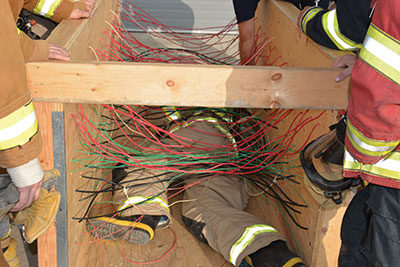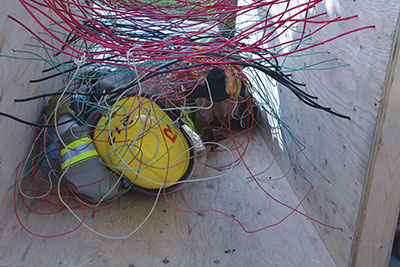
Features
Structural
Training
Trainer’s Corner: September 2014
Yes, we are still talking about giving firefighters the training and permission to call a mayday.
August 28, 2014
By Ed Brouwer
Yes, we are still talking about giving firefighters the training and permission to call a mayday. This is the third column in a series on calling a mayday; I will conclude with a mayday guideline that I hope you will add to your local standard operating guidelines (SOGs).
 |
|
 |
|
| Firefighters must know when to call a mayday – such as when they become tangled – feel comfortable doing so and train on mayday protocols. Photos by Laura King |
When a firefighter calls mayday, the rapid intervention team (RIT) is activated, radio channels are changed, and additional units are dispatched. Many of us have trained extensively on these procedures. We have developed special techniques to get downed firefighters out of narrow openings, tight spaces or up through holes. We carry RIT bags on the apparatuses.
We have almost completely ignored the most important first step: training firefighters to recognize when they are in trouble and need help by calling mayday.
What are your department’s rules for calling mayday and when would your members call mayday?
The problem is that we have not clearly defined what it means to be lost, missing, or trapped, so we leave it up to each firefighter to define these terms.
The odds are that you have never been given specific rules on when to call a mayday. We are trained to be the rescuers, not victims. Yet, the RIT won’t be activated unless a mayday is called – the sooner the better for a chance of survival.
So is it a pride thing? Is it that firefighters hate to admit that they might need to be rescued? I don’t think it is that exactly; I believe we have failed to give clear rules for calling a mayday.
As I said earlier, fire departments need to develop clear rules that specify when a mayday must be called and institute mayday-training programs that firefighters must take and continue to pass throughout their fire-service experiences.
I have also discovered that most incident commanders are not prepared to answer a mayday call. I believe both firefighters and officers need to experience what it may be like to call a mayday before dealing with the real thing. If you put on a SCBA and enter IDLH (immediately dangerous to life and health) environments, you need to drill on calling a mayday.
I encourage you to address these issues with your department and to implement training programs that incorporate mayday conditions and procedures. Practice calling a mayday over the radio: blindfold the firefighters, have them wear gloves, hand them radios, and see if they can turn them on, get the correct channel, push the emergency identifier button, push the talk button, and call a mayday. Have someone on another portable radio serve as communications to receive the information: Who is calling? Where are you? What is the problem?
Every time you have live-fire training, place crew members in a situation in which they must make the mayday decision for themselves. If we want RIT and Saving Our Own to work, we need to give permission to our firefighters to call a mayday.
Just as you have to wear your seatbelt for it to protect you in an accident, you have to call a mayday for the RIT to come to get you out. The big question is, will your members do it?
I thank you in advance on behalf of all future Canadian firefighters who will go home safely after each call. Stay safe, and let no firefighter’s ghost say training let him or her down.
The following mayday protocol was put together several years ago and I submit it to you, updated, as a suggested guideline to be added to your existing SOG. Special thanks to Dr. Burton A. Clarke, Montgomery County FD, MD, Kelowna FD, B.C., Greenwood FD, B.C., Charleston FD, SC and in honor of the Charleston 9. RIP brothers.
OPERATIONAL GUIDELINE FOR MAYDAY
Mayday parameters
- becoming tangled, pinned, or stuck and the low-air alarm activates;
- falling through the roof;
- becoming tangled, pinned, or stuck and do not extricate yourself in 60 seconds;
- if you are caught in a flashover;
- if you fall through the floor;
- if zero visibility and no contact with the hose or lifeline and unaware in which direction the exit is;
- if your primary exit is blocked by fire or collapse and you are not at the secondary exit in 30 seconds;
- if your low-air alarm is activated and you are not at an exit door or window in 30 seconds;
- if you cannot find the exit door or window in 60 seconds.
These nine points may be narrowed down to six: fall; collapse; activated (PASS/low air); caught; lost; trapped
Calling a mayday
Notification of emergency situation (LUNAR):
- L – location (where you are, floor, division of entry, quadrant)
- U – unit number or team
- N – name of firefighter(s) involved
- A – assignment (what you are doing such as vent, search)/Air pressure
- R – resources (what help you need)
Activate your PASS device after giving mayday information.
EIB mayday
- Press the emergency indicator button (EIB) on the portable radio If unable to press the EIB, or if radio is not equipped with EIB, go to step 2.
- On the assigned tactical radio channel, call “mayday, mayday, mayday”
- Give LUNAR. Activate your PASS device after giving mayday information.
Additional self-rescue steps:
Use a tool to make noise; wave your flashlight to draw attention to your location; preserve your air supply; stay with your partner; take actions to self-evacuate (escape); if you cannot escape, retreat to an area of safety (evade); if you cannot evade, attempt to dig in (entrench) in the area of danger; inform the IC of any actions you take so RIT is updated on all actions taken in effort to escape, evade or entrench.
EIB-only mayday
A mayday may also be transmitted by pressing only the EIB, with no follow-up voice transmission.
When only an EIB is activated, dispatch will notify command of the activation. Command will make one attempt to contact the unit verbally. If the unit does not acknowledge this attempt, the unit will be considered a mayday.
A witnessed report
A witnessed report is an occurrence during which personnel see a person or persons trapped: a fall through a roof or floor, or firefighters caught in a flashover, and declare a mayday.
PAR (personnel accountability report)
A unit that is not accounted for in a PAR will be declared mayday.
The rest of the fire ground
All other units must continue their assigned operation unless the IC directs otherwise. This prevents freelancing and helps keep control of the fire incident. Direct knowledge of the mayday situation should be transmitted to the IC through the command structure.
Mayday, dispatch, alert tones
The IC will request dispatch to sound the pre-alert tone and switch all units, except the mayday personnel, the IC or the IC’s designee, and the RIT, to an alternate talk group. If the IC does not acknowledge a mayday, any unit hearing the call must alert the IC of the mayday. The IC will try to determine the exact location of the mayday personnel and order the RIT to intervene as necessary.
RIT assignment
The IC or the IC’s designee will assign the RIT and any other resources necessary to rescue the mayday firefighter. If the IC or the IC’s designee cannot determine the exact location of the firefighter, the RIT should be sent to the firefighter’s (or firefighters’) last known location.
PAR after mayday declaration
Once all units (except the mayday personnel, the IC or the IC’s designee, and the RIT) have switched to an alternate talk group, command will conduct a PAR. Divisions/groups that do not report after two attempts will be considered mayday. If divisions and groups have not been assigned, the PAR will be by unit.
When mayday is over
The IC will announce to all operating units and dispatch when the incident has stabilized and there is a return to normal operations. Consider redirecting the incident-action plan and incident priorities to a high-priority search-and-rescue operation. Development of a rescue action plan is critical.
Additional resources
Consider requesting appropriate resources to meet the needs of the event as necessary, including: an additional alarm; command staff aide; general staff/operations; logistics, planning; specialized resources-technical rescue capability; EMS assets. It is best to call for these resources early; you can always stand them down.
Reinforcing positions
Consider initiating and/or maintaining fire-attack positions and reinforcing with extra alarm companies as needed.
Expanding command
Consider expanding the command organization by requesting and assigning additional officers of an appropriate level to the rescue area, fire-attack area, command staff, and other critical command positions.
Unassigned resources
Consider withdrawing unassigned resources from the rescue area.
Unauthorized access
Maintain strong supervision in all work areas. Control and restrict all unauthorized entries into the structure or search-rescue area.
Command presence
It is critical that the IC create a strong command presence.
Ed Brouwer is the chief instructor for Canwest Fire in Osoyoos, B.C., and Greenwood Fire and Rescue. Contact Ed at ebrouwer@canwestfire.org
Print this page